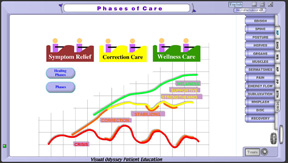 |
This rollercoaster screen gives us the ability to quickly show patients how the symptomatic relief they’ve been searching has taken them downhill: /the first hump being (A) over the counter drugs/the second being hump being (B) prescription drugs/the third hump possibly being (C) shots/ and the last hump being (D) the consideration of surgery to fix the problem. |
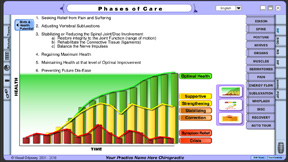 |
It is possible to click on the words along the graph for the stages of care. It is very effective if you do that in conjuction with the rollercoaster just getting to that area or just pass through that area.
The correction rollercoaster takes us up through the process of locating the cause of the problem and focusing on stabilizing and relief, then strengthening that area. Finally, the wellness rollercoaster is where we focus on maintaining what we have gained as well as preventing future disease. |
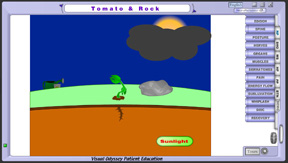 |
Adapted and modified from a B.J. Palmer story, the “Tomato & Rock” section describes the possible troubles of interference through simple analogy. The seedling has the potential to be a whole tomato plant. But sometimes during the life process, things can interfere with the normal potential. |
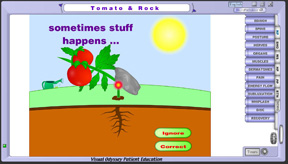 |
Such as, a rock on the stem. Not enough to break the stem, but enough to push the plant over and to impede some of the energy flow that normally goes up and down the stem. The longer the rock is there, the greater the chance the organism has to adapt to the interference. By adapting, the potential of this plant is no longer what it was. When this happens, we want to remove this interference as quickly as possible. We want to support the organism physically and nutritionally, so that it can approach it’s original potential. No matter how minor the interference, if it’s allowed to remain, it will affect the organism because it must adapt and that moves if further and further away from the original potential. |
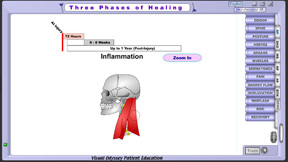 |
This is where we demostrate soft tissue injury and how it first becomes swollen, tender, and hot as it prepares itself for the development of scar tissue. |
| |
The problem with not doing anything, or restricting the range of motion in that area and not correcting any of the segments or joints that need to be corrected, is that it allows that scar tissue to form quite a mass. And that mass will not be reabsorbed with much organization. Therefore there will be a long term reduction in range of motion. |
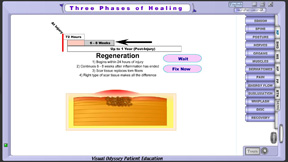 |
Dealing with making sure the scar tissue is developing properly, will allow a greater range of motion. The final phase is the remodeling phase. The body removes the unnecessary scar tissue. This process is improved when the proper function and motion are optimized. |





